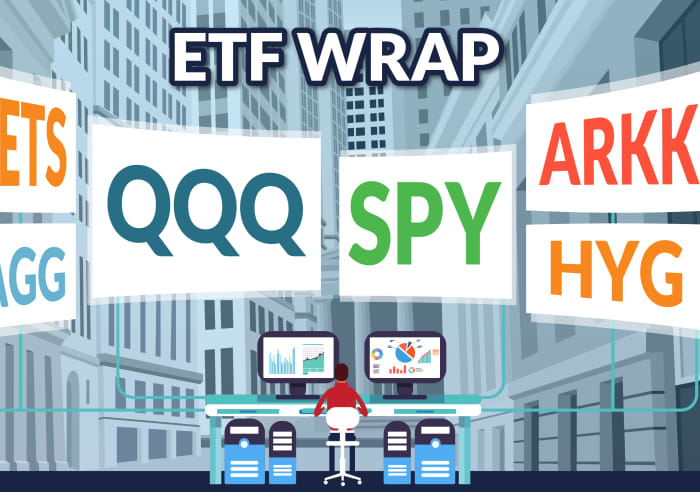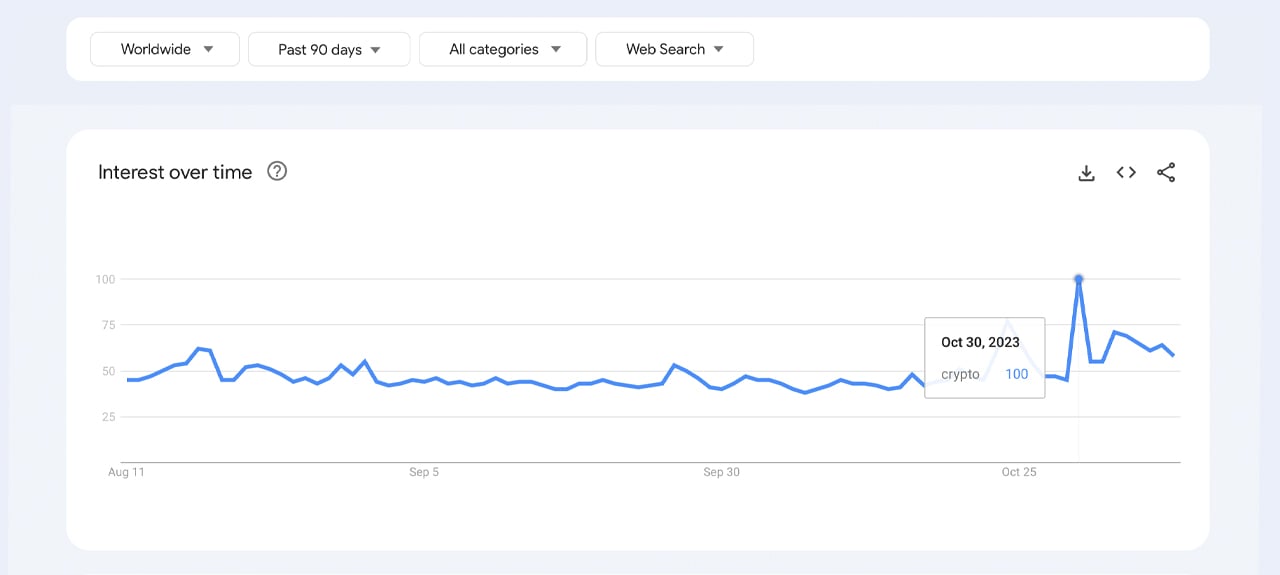‘The switch was flipped’: ETF flows pick up as stocks, bonds head for 2023 gains
December 23, 2023 | by stockcoin.net


In a promising turn of events, ETF flows are beginning to surge as stocks and bonds gear up for gains in 2023. Noteworthy performers this year include the SPDR S&P 500 ETF Trust (SPY), iShares Core U.S. Aggregate Bond ETF (AGG), and Vanguard Total Bond Market ETF (BND). This surge in ETF flows indicates that investors are increasingly willing to embrace greater risk in the markets. Amidst this trend, there has been a rise in demand for active bond ETFs, leading Vanguard and BlackRock to launch new products. Vanguard, however, remains cautious about the U.S. economy’s potential for a “soft landing” and advises investors to increase the duration of their bond portfolios. A striking influx of over $550 billion in inflows has been observed for U.S.-listed ETFs in 2023, with assets under management exceeding $8 trillion. Both index and active funds play a vital role in portfolios, with actively managed strategies aimed at generating enhanced returns. Looking at the past week, top-performing ETFs include the SPDR S&P Metals & Mining ETF (XME) and Amplify Transformational Data Sharing ETF (BLOK), while the iShares MSCI Taiwan ETF (EWT) and iShares Emerging Markets Equity Factor ETF (EMGF) struggled on the lower end. Notable recent ETF launches encompass the Texas Capital Texas Small Cap Equity Index ETF (TXSS), ProShares S&P 500 High Income ETF (ISPY), and PGIM Investments’ actively managed ETFs.
ETF flows picking up
In recent times, there has been a noticeable increase in the flow of funds into Exchange-Traded Funds (ETFs). These investment vehicles have captured the attention of investors due to their unique characteristics and benefits. ETFs are a type of investment fund that trade on stock exchanges, providing investors with access to a wide range of assets. They have gained popularity because of their diversification, transparency, and cost-effectiveness.
One of the reasons for the surge in ETF flows is the increased risk appetite in the markets. As stocks and bonds head for gains in 2023, investors are becoming more optimistic about the potential returns in these asset classes. This optimism is reflected in the increased demand for ETFs, as investors seek to capitalize on the potential upside while managing their risk exposure.
In particular, there has been a growing demand for active bond ETFs. These ETFs differ from traditional bond funds in that they are managed by professional portfolio managers who actively select and manage the underlying bonds. This active management approach allows these ETFs to adapt to changing market conditions and potentially generate higher returns. Vanguard and BlackRock, two leading asset management firms, have recently launched new active bond ETFs to meet this demand.
▶ [Kucoin] Transaction fee 0% discount CODE◀
US-listed ETFs attract over $550 billion in inflows
The surge in ETF flows is not limited to a specific market. In the United States, ETFs listed on US exchanges have attracted over $550 billion in inflows in 2023 alone. This significant influx of capital into ETFs demonstrates the growing popularity of these investment vehicles among investors. The total assets under management (AUM) of US-listed ETFs have also surpassed $8 trillion, highlighting their dominance in the investment landscape.
Stocks and bonds heading for gains in 2023
The performance of stocks and bonds in 2023 has been favorable so far, further driving the interest in ETFs. The SPDR S&P 500 ETF Trust (SPY), which tracks the performance of the S&P 500 Index, has experienced solid gains. The S&P 500, composed of 500 large US companies, is often considered a benchmark for the broader stock market.
On the bond side, the iShares Core U.S. Aggregate Bond ETF (AGG) and Vanguard Total Bond Market ETF (BND) have also delivered strong performance. These bond ETFs provide investors with exposure to a diversified portfolio of US government, corporate, and mortgage-backed securities. As interest rates remain relatively low and the US economy shows signs of recovery, these bond ETFs have benefited from the positive market conditions.
Vanguard’s skepticism and bond portfolio advice
Despite the positive outlook for stocks and bonds, Vanguard, one of the largest investment management companies, remains skeptical of a “soft landing” for the US economy. Vanguard’s experts believe that investors should be cautious and consider adding duration to their bond portfolios.
Adding duration to a bond portfolio refers to increasing the portfolio’s sensitivity to interest rate changes. The longer the duration, the more reactive the bond prices will be to fluctuations in interest rates. By adding duration, investors can potentially benefit from any potential decline in interest rates, resulting in higher bond prices and capital appreciation.
Vanguard’s advice highlights the importance of considering different investment strategies and tailoring portfolios to meet specific objectives and risk tolerances.
Rise of active bond ETFs
In response to the increased demand for active bond ETFs, Vanguard and BlackRock have recently launched new offerings in this space. Active bond ETFs aim to provide investors with the benefits of active management while utilizing the structure and flexibility of ETFs.
Vanguard’s active bond ETFs are managed by a team of experienced portfolio managers who leverage their expertise to actively select and manage the underlying bonds. These active managers have the ability to make strategic investment decisions to capitalize on changing market conditions and potential opportunities.
The rise of active bond ETFs reflects the evolving landscape of ETFs, offering investors a broader range of options and strategies to choose from based on their investment preferences and goals.
Overview of active bond ETF market trend
The active bond ETF market has gained significant traction in recent years. Investors are increasingly attracted to these funds due to the potential for higher returns and active management expertise. Active bond ETFs provide an alternative to traditional passive bond ETFs, where the portfolio is simply designed to replicate the performance of an underlying bond index.
Active bond ETFs offer the advantage of flexibility and adaptability. The portfolio managers have the ability to adjust the fund’s holdings based on their assessment of the market conditions and the creditworthiness of the underlying bonds. This active management approach can potentially result in enhanced returns and better risk management.
As investors continue to seek out opportunities in the bond market, active bond ETFs are expected to play a more significant role in their portfolios.
Role of both index and active funds in portfolios
Both index funds and actively managed funds have their place in investors’ portfolios. Index funds offer broad market exposure and are designed to track the performance of a specific index. These funds are typically passively managed, meaning they aim to replicate the performance of the index rather than outperform it. Index funds are popular for their low costs and diversification benefits.
On the other hand, actively managed funds are managed by professionals who actively select and manage the fund’s investments. These managers aim to outperform the market or a specific benchmark through their investment decisions and strategies. Actively managed funds offer the potential for excess returns, but they also come with higher fees and the risk of underperformance.
A well-diversified portfolio can benefit from a combination of both index and actively managed funds. Index funds can provide broad market exposure and serve as a foundation for the portfolio, while actively managed funds can be used to add potential alpha and diversify risk. The appropriate allocation between these two types of funds depends on an investor’s risk appetite, investment goals, and time horizon.
Importance of index funds
Index funds play a crucial role in investors’ portfolios, offering a cost-effective way to achieve broad market exposure. These funds passively track the performance of a specific index, such as the S&P 500 or the Aggregate Bond Index. By investing in an index fund, investors gain exposure to a diversified portfolio of securities that mimic the performance of the underlying index.
One of the key advantages of index funds is their low fees. Since these funds are passively managed and aim to replicate the performance of the index, they require less active management and incur lower costs compared to actively managed funds. This cost advantage can significantly benefit investors, especially over the long term, as fees can eat into investment returns.
Additionally, index funds provide investors with instant diversification. By investing in an index fund, investors gain exposure to a wide range of securities within the index. This diversification helps spread the risk across multiple companies or bonds, reducing the impact of any single investment’s performance on the overall portfolio.
Benefits of actively managed strategies
While index funds have their merits, actively managed strategies offer unique benefits that can enhance portfolio returns. Actively managed funds are overseen by professional fund managers who use their expertise to make investment decisions and capitalize on market opportunities. These managers actively research potential investment opportunities, analyze market trends, and adjust the portfolio accordingly.
One of the main advantages of actively managed strategies is the potential for excess returns. By actively selecting investments and making tactical investment decisions, fund managers aim to outperform the market or a specific benchmark. This outperformance can lead to higher returns for investors compared to a passive investment approach.
Active management also allows for flexibility and adaptation to market conditions. Fund managers can adjust the portfolio’s holdings based on their assessment of market trends, valuations, and economic developments. This ability to respond to changing market dynamics can potentially result in better risk management and improved portfolio performance.
Aiming for excess returns
The pursuit of excess returns is a primary objective for many investors. Excess returns, also known as alpha, represent the returns generated above the benchmark or market average. Active management strategies aim to achieve excess returns by selecting investments that they believe will outperform the market.
While the potential for excess returns is an attractive proposition, it is important to note that active management is not without risks. Not all active managers are successful in consistently outperforming their benchmarks, and fees associated with actively managed funds can erode returns, especially if the performance does not justify the higher cost.
Investors aiming for excess returns should carefully evaluate the track record and investment strategy of any actively managed funds they consider. It is essential to ensure that the fund manager has a strong investment process and a proven ability to generate consistent alpha over different market cycles.
Top-performing ETFs of the past week
In the past week, some ETFs have shown remarkable performance and delivered strong returns for investors. The SPDR S&P Metals & Mining ETF (XME) has stood out as a top performer. This ETF focuses on companies involved in the mining and production of metals and minerals, allowing investors to gain exposure to this specific sector.
Another top-performing ETF is the Amplify Transformational Data Sharing ETF (BLOK). This ETF focuses on companies that are involved in the blockchain technology space. Blockchain technology has gained significant attention for its potential to revolutionize various industries, leading to increased investor interest in this sector.
Investors should note that past performance is not indicative of future results. It is crucial to conduct thorough research and due diligence before investing in any ETF or investment product.
Bottom-performing ETFs of the past week
While some ETFs have enjoyed positive performance, others have experienced a decline in value. The iShares MSCI Taiwan ETF (EWT) is among the bottom performers of the past week. This ETF provides exposure to a broad range of companies in Taiwan. The performance of this ETF may be influenced by factors such as geopolitical developments, economic conditions, and company-specific news.
Another bottom-performing ETF is the iShares Emerging Markets Equity Factor ETF (EMGF). This ETF focuses on emerging market equities, which can be more volatile compared to developed markets. The performance of this ETF may be impacted by factors such as political instability, currency fluctuations, and economic fundamentals of the countries included in the index.
Investors should carefully consider their risk tolerance and investment objectives before investing in ETFs, especially those that focus on specific sectors or regions.
Recent ETF launches
The ETF industry continues to evolve and expand, with new products being introduced to meet the demands of investors. Some recent ETF launches include:
- The Texas Capital Texas Small Cap Equity Index ETF (TXSS) aims to provide investors with exposure to small-cap companies located in Texas. This ETF allows investors to participate in the potential growth of smaller Texas-based companies, which may have unique insights and opportunities within the state.
- The ProShares S&P 500 High Income ETF (ISPY) is designed to provide investors with attractive yield potential. This ETF seeks to generate income by investing in high-yielding securities within the S&P 500 Index. It offers an alternative for investors looking for income-generating strategies within the equity space.
- PGIM Investments, a global asset management firm, has recently introduced actively managed ETFs. These actively managed ETFs combine the benefits of ETFs, such as intraday liquidity and transparency, with the expertise of professional portfolio managers. Investors can now access actively managed strategies through the ETF structure, providing them with more options and flexibility in their investment portfolios.
These recent launches showcase the continuous innovation and development within the ETF industry, providing investors with a broader range of investment opportunities to choose from.
In conclusion, the surge in ETF flows reflects investors’ increased risk appetite as stocks and bonds head for gains in 2023. The performance of ETFs such as SPY, AGG, and BND has been positive, attracting the attention of investors. The demand for active bond ETFs has also grown, leading to the launch of new offerings by Vanguard and BlackRock. Both index and active funds have a role in portfolios, with actively managed strategies aiming to produce excess returns. Investors should consider the top-performing and bottom-performing ETFs of the past week, while also monitoring recent ETF launches to stay informed about new investment opportunities.
▶ [Kucoin] Transaction fee 0% discount CODE◀

RELATED POSTS
View all







